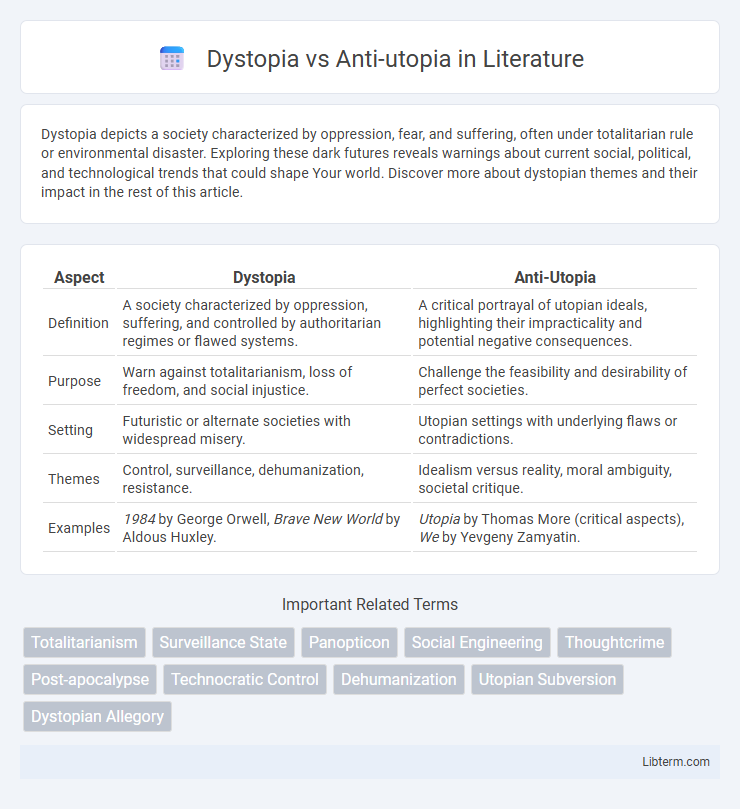Dystopia depicts a society characterized by oppression, fear, and suffering, often under totalitarian rule or environmental disaster. Exploring these dark futures reveals warnings about current social, political, and technological trends that could shape Your world. Discover more about dystopian themes and their impact in the rest of this article.
Table of Comparison
| Aspect | Dystopia | Anti-Utopia |
|---|---|---|
| Definition | A society characterized by oppression, suffering, and controlled by authoritarian regimes or flawed systems. | A critical portrayal of utopian ideals, highlighting their impracticality and potential negative consequences. |
| Purpose | Warn against totalitarianism, loss of freedom, and social injustice. | Challenge the feasibility and desirability of perfect societies. |
| Setting | Futuristic or alternate societies with widespread misery. | Utopian settings with underlying flaws or contradictions. |
| Themes | Control, surveillance, dehumanization, resistance. | Idealism versus reality, moral ambiguity, societal critique. |
| Examples | 1984 by George Orwell, Brave New World by Aldous Huxley. | Utopia by Thomas More (critical aspects), We by Yevgeny Zamyatin. |
Introduction to Dystopia and Anti-Utopia
Dystopia represents a fictional society characterized by oppression, control, and widespread suffering, often envisioned as a consequence of political or technological failures. Anti-utopia serves as a critical response to utopian ideals by illustrating the dark outcomes of attempting to create a perfect society. Both concepts explore themes of dehumanization and societal collapse, revealing the complexities and dangers inherent in idealized social visions.
Defining Dystopia: Core Characteristics
Dystopia is defined by its portrayal of a society characterized by oppressive control, pervasive suffering, and the erosion of individual freedoms. Core characteristics include authoritarian governance, environmental degradation, social injustice, and the manipulation of truth or information. These elements create a grim reality intended to critique contemporary societal flaws and warn against possible futures.
What Is an Anti-Utopia? Key Features
An anti-utopia is a fictional world characterized by oppressive societal control, where attempts to create a perfect society result in unintended negative consequences. Key features include authoritarian governance, the suppression of individuality, and the presence of widespread social injustice. This genre highlights the failure of utopian ideals by exposing dystopian realities beneath seemingly perfect facades.
Historical Origins of Dystopian and Anti-Utopian Literature
Dystopian and anti-utopian literature emerged prominently during the early 20th century, reflecting societal anxieties about rapid industrialization, totalitarian regimes, and the failures of utopian ideals. Influential works like Yevgeny Zamyatin's "We" (1924) and Aldous Huxley's "Brave New World" (1932) critically portrayed oppressive futures that expose the dark side of idealistic visions. These genres evolved as reactions to the Enlightenment's optimistic projections, highlighting the potential for dystopia within attempts at creating perfect societies.
Notable Examples: Dystopian vs. Anti-Utopian Works
Notable dystopian works include George Orwell's *1984* and Aldous Huxley's *Brave New World*, which depict oppressive societies characterized by totalitarian control and loss of individuality. Anti-utopian literature often overlaps with dystopian themes but emphasizes the failure or inherent flaws in utopian ideals, as seen in Yevgeny Zamyatin's *We* and Ursula K. Le Guin's *The Dispossessed*. These texts critically explore the dark consequences of attempts to create perfect societies, highlighting the complexities between idealism and reality.
Philosophical Foundations of Both Concepts
Dystopia and anti-utopia both explore societal flaws but differ philosophically; dystopia portrays a nightmarish society resulting from the deprivation of fundamental human values, emphasizing the consequences of totalitarianism and loss of individuality. Anti-utopia, while similar, critically rejects idealistic utopian visions by highlighting inherent contradictions and unintended outcomes in attempts to create a perfect society. Both concepts draw from Enlightenment skepticism and critical theory, analyzing power structures, human nature, and ethical dilemmas in constructing social order.
Social and Political Functions: Comparison
Dystopias depict oppressive social hierarchies and authoritarian political regimes designed to warn against the dangers of extreme control, often exposing the erosion of individual freedoms and systemic injustice. Anti-utopias critique idealistic visions of society by illustrating the inherent flaws and unintended consequences of pursuing perfection, highlighting social alienation and political corruption. Both genres serve as cautionary frameworks that interrogate power dynamics, ideological rigidity, and the social impact of governance models.
Impact on Readers and Society
Dystopia presents a grim vision of future societies plagued by oppression, surveillance, and loss of individual freedoms, provoking readers to critically reflect on real-world political and social issues. Anti-utopia often highlights the failure of idealistic social experiments, revealing inherent human flaws and ethical dilemmas that challenge utopian ideals. Both genres influence societal awareness by inspiring activism and cautioning against authoritarianism, ultimately shaping public discourse about governance, technology, and human rights.
Modern Interpretations in Media
Modern interpretations of dystopia and anti-utopia in media frequently explore complex societal issues such as surveillance, authoritarianism, and environmental collapse, highlighting the tension between oppressive control and human resilience. Films like "Blade Runner 2049" and series like "Black Mirror" exemplify anti-utopian narratives by showcasing flawed societies where humanity strives to reclaim individuality despite systemic dehumanization. These portrayals deepen the understanding of dystopian themes by emphasizing moral ambiguity and the potential for subversion within oppressive regimes.
Conclusion: The Ongoing Relevance of Dystopia and Anti-Utopia
The persistent exploration of dystopia and anti-utopia in literature and media underscores their critical roles in reflecting societal fears and cautioning against potential futures driven by authoritarianism, environmental collapse, and technological misuse. These narratives remain vital tools for cultural critique and speculative thinking, helping audiences understand complex social dynamics and envision alternative pathways. The enduring relevance of dystopian and anti-utopian themes highlights the perpetual human concern for freedom, justice, and the survival of democratic values.
Dystopia Infographic

 libterm.com
libterm.com